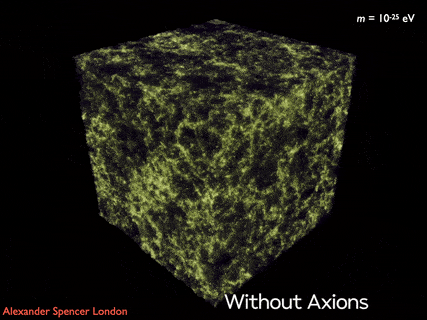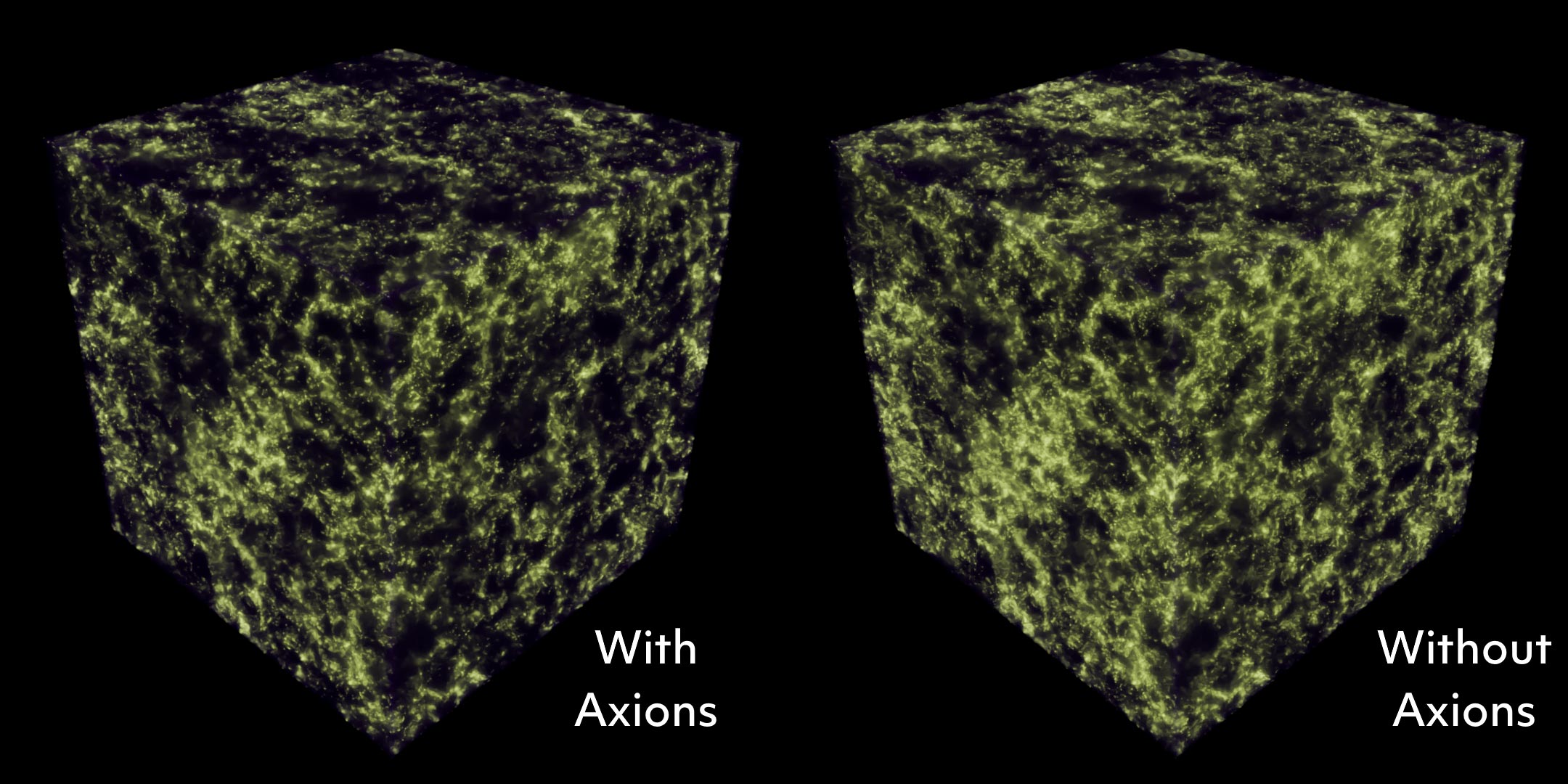
Uma simulação de computador de uma parte do universo com ou sem eixos mostrando como a estrutura da teia cósmica da matéria escura é menos irregular se tiver eixos. Quanto ao tamanho, a Via Láctea ficará dentro de um dos minúsculos pontos verdes chamados halos. Crédito: Alexander Spencer Londres/Alex Lago.
Em um novo estudo, os pesquisadores sugerem que a falta de massa do universo indica que a matéria escura é composta de partículas ultraleves hipotéticas chamadas axions. Se confirmado, isso pode ter amplas implicações para nossa compreensão do universo e pode até fornecer suporte para a teoria das cordas.
Em um estudo publicado em 14 de junho no Jornal de Cosmologia e AstrofísicaPesquisadores da Universidade de Toronto revelaram um avanço teórico que pode explicar tanto a natureza invisível da matéria escura quanto a estrutura em larga escala do universo conhecida como teia cósmica. O resultado estabelece um novo vínculo entre esses dois problemas antigos da astronomia, abrindo novas possibilidades para a compreensão do universo.
A pesquisa sugere que o “problema de aglomeração”, que gira em torno de uma distribuição inesperadamente uniforme de matéria em grandes escalas em todo o universo, pode ser um sinal de que a matéria escura é composta de partículas ultraleves hipotéticas chamadas áxions. As implicações de provar a existência de eixos difíceis de detectar vão muito além da compreensão da matéria escura e podem abordar questões fundamentais sobre a natureza do próprio universo.

Um mapa de galáxias no universo local visto pelo Sloan Digital Sky Survey, que os pesquisadores usaram para testar a teoria do áxion. Cada ponto é uma localização galáctica e a Terra está no meio do mapa. Crédito: Sloan Digital Sky Survey
“Se for confirmado por futuras observações de telescópios e experimentos de laboratório, encontrar matéria escura a partir de áxions será uma das descobertas mais importantes deste século”, diz o principal autor Keir Rogers, pesquisador da Dunlap no Dunlap Institute for Astronomy and Astrophysics no College of Artes e Astrofísica da Ciência na Universidade de Toronto. . “Ao mesmo tempo, nossos resultados apontam para uma explicação de por que o universo é menos irregular do que pensávamos, uma observação que se tornou cada vez mais aparente na última década e atualmente deixa nossa teoria do universo incerta”.

Ao moldar o universo, a gravidade constrói uma estrutura de filamentos semelhante a uma teia de aranha que une galáxias e aglomerados de galáxias ao longo de pontes invisíveis com centenas de milhões de anos-luz de comprimento. Isso é conhecido como teia cósmica. Crédito: Volker Sprengel (Instituto Max Planck de Astrofísica) et al.
A matéria escura, que compõe 85% da massa do universo, é invisível porque não interage com a luz. Os cientistas estudam os efeitos da gravidade na matéria visível para entender como ela é distribuída no universo.
Uma das principais teorias propõe que a matéria escura é feita de áxions, descritos na mecânica quântica como “nebulosos” por causa de seu comportamento ondulatório. Ao contrário de partículas pontuais discretas, os axions podem ter comprimentos de onda mais longos do que galáxias inteiras. Essa imprecisão afeta a composição e distribuição da matéria escura, o que pode explicar por que o universo é menos irregular do que seria esperado em um universo sem eixos.

Uma simulação de computador de uma parte do universo com ou sem eixos mostrando como a estrutura da teia cósmica da matéria escura é menos irregular se tiver eixos. Quanto ao tamanho, a Via Láctea ficará dentro de um dos minúsculos pontos verdes chamados halos. Crédito: Alexander Spencer Londres/Alex Lago
Essa falta de aglomeração foi observada em pesquisas de grandes galáxias, desafiando a outra teoria predominante de que a matéria escura consiste apenas em partículas subatômicas pesadas de interação fraca chamadas WIMPs. Apesar de experimentos como o Large Hadron Collider, nenhuma evidência foi encontrada para apoiar a existência de WIMPs.

Keir Rogers, principal autor do estudo e pesquisador Dunlap do Instituto Dunlap de Astronomia e Astrofísica. Crédito: Cortesia Keir Rogers
“Na ciência, quando as ideias são desvendadas, novas descobertas são feitas e velhos problemas são resolvidos”, diz Rogers.
Para o estudo, a equipe de pesquisa – liderada por Rogers e incluindo membros do grupo de pesquisa do Professor Associado Rene Hluczek no Instituto Dunlap, bem como da Universidade da Pensilvânia, Instituto de Estudos Avançados,[{” attribute=””>Columbia University and King’s College London — analyzed observations of relic light from the Big Bang, known as the Cosmic Microwave Background (CMB), obtained from the Planck 2018, Atacama Cosmology Telescope and South Pole Telescope surveys. The researchers compared these CMB data with galaxy clustering data from the Baryon Oscillation Spectroscopic Survey (BOSS), which maps the positions of approximately a million galaxies in the nearby universe. By studying the distribution of galaxies, which mirrors the behavior of dark matter under gravitational forces, they measured fluctuations in the amount of matter throughout the universe and confirmed its reduced clumpiness compared to predictions.
The researchers then conducted computer simulations to predict the appearance of relic light and the distribution of galaxies in a universe with long dark matter waves. These calculations aligned with CMB data from the Big Bang and galaxy clustering data, supporting the notion that fuzzy axions could account for the clumpiness problem.
Future research will involve large-scale surveys to map millions of galaxies and provide precise measurements of clumpiness, including observations over the next decade with the Rubin Observatory. The researchers hope to compare their theory to direct observations of dark matter through gravitational lensing, an effect where dark matter clumpiness is measured by how much it bends the light from distant galaxies, akin to a giant magnifying glass. They also plan to investigate how galaxies expel gas into space and how this affects the dark matter distribution to further confirm their results.
Understanding the nature of dark matter is one of the most pressing fundamental questions and key to understanding the origin and future of the universe.
Presently, scientists do not have a single theory that simultaneously explains gravity and quantum mechanics — a theory of everything. The most popular theory of everything over the last few decades is string theory, which posits another level below the quantum level, where everything is made of string-like excitations of energy. According to Rogers, detecting a fuzzy axion particle could be a hint that the string theory of everything is correct.
“We have the tools now that could enable us to finally understand something experimentally about the century-old mystery of dark matter, even in the next decade or so—and that could give us hints to answers about even bigger theoretical questions,” says Rogers. “The hope is that the puzzling elements of the universe are solvable.”
Reference: “Ultra-light axions and the S8 tension: joint constraints from the cosmic microwave background and galaxy clustering” by Keir K. Rogers, Renée Hložek, Alex Laguë, Mikhail M. Ivanov, Oliver H.E. Philcox, Giovanni Cabass, Kazuyuki Akitsu and David J.E. Marsh, 14 June 2023, Journal of Cosmology and Astroparticle Physics.
DOI: 10.1088/1475-7516/2023/06/023
National Aeronautics and Space Administration, Natural Sciences and Engineering Research Council of Canada, David Dunlap family and University of Toronto, Connaught Fund.

“Aficionado por música. Jogador. Praticante de álcool. Leitor profissional. Estudioso da web.”

